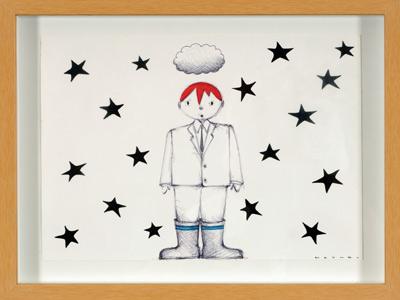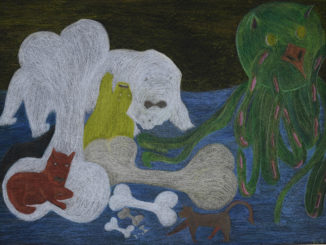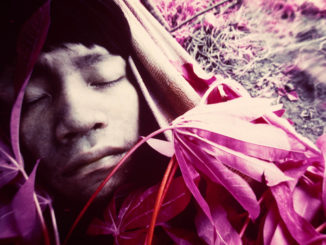 It has been said that art is a reflection of the world and time in which we live in. Parting from this notion, would it be too far-fetched to assume that history could be studied through art? Maybe it would not have been so hard to stay up during fourth period history had our high school text-books been filled with images of the Sistine Chapel, and the works of Rembrandt, Picasso and other greats rather than words. This exploration of history through art does not only apply to the history of politics and the expansion of nations but more specifically to the resulting personal histories of these grand events.
It has been said that art is a reflection of the world and time in which we live in. Parting from this notion, would it be too far-fetched to assume that history could be studied through art? Maybe it would not have been so hard to stay up during fourth period history had our high school text-books been filled with images of the Sistine Chapel, and the works of Rembrandt, Picasso and other greats rather than words. This exploration of history through art does not only apply to the history of politics and the expansion of nations but more specifically to the resulting personal histories of these grand events.
If Leonel Matheu’s work would be the only resource available to a future historian, what would his conclusion of our era be? Basing his study on Matheu’s focus on lonely figures, this historian might conclude that ours is an independent society – a society where, due to technology in the modern world – we have become solitary and less of a social species. Our worlds have been cluttered with unnecessary things and even more so with the desire for these unnecessary things. We have become entirely materialistic in a world where demand is never satisfied with its supply.
In an interview by Myrna W. Curras, Matheu explains, “If my world is saturated by artifacts, aeroplanes, factories and buildings, that sometimes constitute an obstacle to the human essence or transform it into something diminutive, or non-existent, this is because the contemporary environment overwhelms the human-being. My paintings portray the violent struggle that is fought for vital space. I also try to convey the current bombardment that we suffer not only through marketing tactics but through everything that drives us to consume, to travel, to compete, to meet the economic and social challenges.”
However discouraging Matheu’s notion of peace lost in a material world may seem to this historian at first, after taking a closer look he would also find great hope in this work. This fortunate historian from the future would learn, as we have, that Matheu’s philosophy, which is clear in his work, is that it is in man’s hands to be good or to be evil. It is in man’s hands to use the technology that seems to have isolated us from each other and steer it back onto the right direction. Perhaps the machine is not the problem, perhaps the operator is. Matheu clarifies that progress is not the problem and that it should not be eliminated but rather considered and combined with social relations.
Leonel Matheu takes this artistic mirror of history to the deepest level by reflecting emotion and inspiring subconscious analysis in the spectator. It is Matheu’s concentration on the philosophy and meaning behind his work that draws the spectator in and triggers the desire to analyze and dissect the work in relation to personal life. The artist’s mastery of the portrayal of the subconscious mind through innocent graphics is obvious in every one of his creations.
Matheu focuses on making art an interactive experience by making sure that it stimulates and captivates the spectator’s mind; this stimulation should result in the development of a philosophical analysis of one’s own subconscious, what more could an art lover ask for? Matheu still carries his origins as a graphic designer, and as such, believes in his responsibility to use this medium to encourage our constant awareness of the art around us. Leonel Matheu’s use of images translates into a graphic language that communicates everyday life and everyday emotions.
{mospagebreak}
Matheu says, “The use of this language is like the use of a hammer to the wall between the painting and the spectator.” His enthusiasm to communicate through graphics is exactly what drove Matheu to pursue a life of art. Think of Matheu as an inspirational imager rather than an inspirational speaker. The speaker’s goal is to uplift the listener through his words and reassuring concepts of an optimistic future; Matheu accomplishes the same with his spectators through his graphics and colors. At first his images are reminiscent of childhood dreams and odd characters, yet it is the artist’s composition of these images that challenges the mind of the spectator and triggers nostalgia and recollection of subconscious activity.
His interactive concept of Pedestriart, for example, would bring art to the streets in the form of altered pedestrian signs.These altered signs would depict art by Matheu that he says, “feeds on a compilation of modern, ancestral, and cultural graphics” rather than typical “cross” and “do not cross” symbols. This project will be an intervention of a very urban area where the installation will undoubtedly stand out and call for attention. These traffic signs will use Matheu’s iconography to transmit the desired message to the city’s pedestrians. The purpose of this installation is stimulation – stimulation of the mind through visualization during everyday activities like walking to work, walking to school, or walking to the store. Though the pedestrian is given the image to consider, it is up to each one to develop a personal interpretation through this stimulus of the subconscious.
The pieces will be placed in the city in strategic corners and intersections to form a coherent juxtaposition from which pedestrians may gain understanding of the concept as a whole as well as from each individual sign. This strategic placement of the signs would also guide an attentive pedestrian to follow each sign to ultimately reach the central point of the project. With this integration of art into the everyday scenery of the common city street, Matheu hopes to reach a larger audience and in turn broaden our artistic interaction.
Matheu says, “I have always seen myself as an artist who designs book covers, giving the freedom to the audience to reach an interpretation for themselves.” Those of us who have experienced Matheu’s work would have to agree with the artist’s words as none of his pieces are closed to limited interpretation but rather open to endless possibilities as his work, like a book, should not be judged by its cover either. His goal is to awaken the spectators mind, memory, and perhaps even creativity through images that have been called reminiscent of childhood thoughts and fantasies. Matheu’s optimism shines through in his work and philosophies. His views on the betterment of the world by taking the two counterparts – technology and social consciousness – and combining them through art rather than putting them up against each other, are of great appeal to the social activist in all of us. It would be hard to attend, and inevitably interact with, one of Leonel Matheu’s exhibitions and not leave with a newfound passion for what has been lost and can still be saved.



Be the first to comment